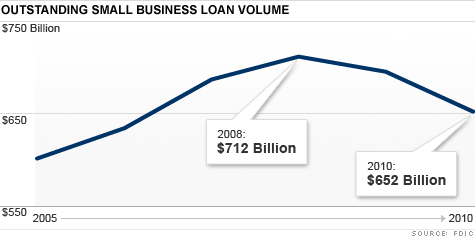
NEW YORK (CNNMoney) -- The numbers back up what small business owners have been saying for two years: Main Street suffered a brutal credit crunch.
The total value of outstanding loans to small businesses plunged by $43 billion, or 6.2%, between June 2009 and June 2010, according to a report released this week by the Small Business Administration. That's a drop of $59 billion, or 8.3%, from June 2008.
Measuring lending to small businesses is like trying to nail Jell-O to a wall, because every institution and government agency has its own definition of what constitutes a small business. For this week's study, the SBA drew on data reported to the Federal Deposit Insurance Corp., which tracks lending by the banks it regulates. Both the SBA and FDIC assume that all commercial loans of $1 million or less went to a small business.
The drop-off in small business loans came against an overall backdrop of reduced lending. Lending to large businesses -- measured by commercial loans of more than $1 million -- dropped by $156.2 billion, or 8.9%, between 2009 and 2010.
Reduced demand played some role in the declines: As sales dried up through the recession, fewer businesses needed loans for expansion and capital investments.
But government watchdogs have been concerned that the credit clampdown went too far, cutting viable small businesses off from an essential financial resource. Larger businesses have access to other capital sources, like selling stock or courting outside investors. A typical small business, like your local dry cleaner, has one just option when it comes to getting a credit line: a bank.
"Small businesses are important to the national and local economy, but their existence depends on their ability to access credit," the SBA said in its report.
The SBA's own lending program, which doesn't make direct loans but insures qualifying bank loans against default, also dwindled during the recession.
The number of loans backed by the agency's flagship 7(a) program fell sharply from 2007 to 2008 and plunged again the following year. The total dollar value of the loans also plummeted, dropping 27% in 2009 to $9.3 billion.
A series of stimulus-funded SBA loan sweeteners that launched in early 2009 helped reverse the decline: SBA-backed lending rose in the 2010 fiscal year (which ended Sept. 30) to $12.6 billion, just shy of 2008's total. Those stimulus efforts were discontinued on Dec. 31.
No easy way out: Policymakers have made a big show of studying the small business credit crunch. The Federal Reserve hosted a series of more than 40 meetings across the country last year with small businesses, financial institutions, trade groups and regulators.
Its conclusion? The problem is "complex and multifaceted." That's what Julie Stackhouse, a senior vice president with the Federal Reserve Bank of St. Louis, wrote in the Fed report summarizing the input from the meetings.
The Fed's solution: America is going to have to brainstorm its way out of this one.
As an example of "an innovative effort to disperse credit," the Fed cited a pilot program Sam's Club launched last year to offer discounted SBA loans to its shoppers.
"The entrepreneurial spirit, which is indicative of most small businesspersons, is going to be critical for those entities to come up with solutions -- whether private or public, for profit or nonprofit, or a consortium of parties working in concert -- to provide credit," Stackhouse wrote in the Fed report.
The government has launched some specific policy efforts aimed at relieving the small business lending crunch -- but data from the SBA's lending report suggests that those programs may miss the mark.
The Small Business Jobs Act, passed in September, authorized the creation of a $30 billion fund run by the Treasury Department that offers ultra-cheap capital to banks with less than $10 billion in assets. The idea is that pumping capital into small banks will get money in the hands of Main Street businesses.
But the SBA's new lending report includes a fresh reminder that small banks play a small role in the overall lending market.
"The largest lenders -- those with assets exceeding $10 billion -- continued to dominate the small business loan market," the SBA wrote. ![]()



| Overnight Avg Rate | Latest | Change | Last Week |
|---|---|---|---|
| 30 yr fixed | 3.80% | 3.88% | |
| 15 yr fixed | 3.20% | 3.23% | |
| 5/1 ARM | 3.84% | 3.88% | |
| 30 yr refi | 3.82% | 3.93% | |
| 15 yr refi | 3.20% | 3.23% |
Today's featured rates:



|
Bankrupt toy retailer tells bankruptcy court it is looking at possibly reviving the Toys 'R' Us and Babies 'R' Us brands. More |
Land O'Lakes CEO Beth Ford charts her career path, from her first job to becoming the first openly gay CEO at a Fortune 500 company in an interview with CNN's Boss Files. More |
Honda and General Motors are creating a new generation of fully autonomous vehicles. More |
In 1998, Ntsiki Biyela won a scholarship to study wine making. Now she's about to launch her own brand. More |
Whether you hedge inflation or look for a return that outpaces inflation, here's how to prepare. More |